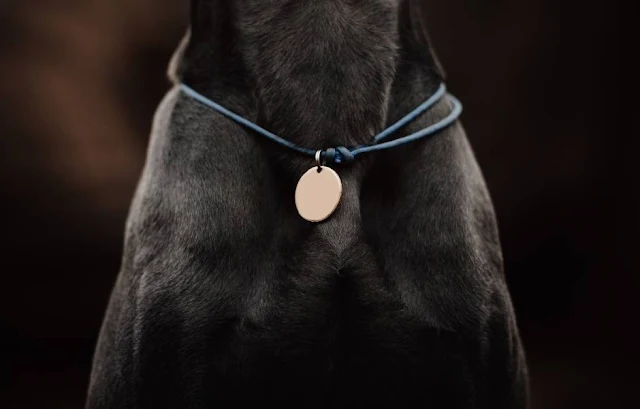Last updated: January 2025
A walk in the park could cost you thousands if your dog’s ID isn’t up to scratch. While microchipping grabs the headlines, it’s the humble collar tag that’s often forgotten—and it could land you with a £2,000 fine. Here’s what every UK dog owner needs to know to stay on the right side of the law and keep their furry friend safe.
Every dog owner in the UK faces a potential £2,000 fine if their pet doesn’t wear proper identification when out in public. This legal requirement, often overlooked by many pet owners, extends beyond simple microchipping and involves specific collar requirements that every responsible owner must understand.

Legal Requirements for Dog ID Tags in the UK
What the Law Actually Says
Under UK law, all dogs must wear a collar displaying their owner’s name and address when in public spaces. The legislation is clear and applies to dogs of all breeds and sizes that are eight weeks old or older.
Key legal requirements:
- The owner’s name must be clearly visible
- The current address must be displayed
- Information must be legible and durable
- A telephone number is recommended but not mandatory
Understanding the £2,000 Fine
The maximum penalty for non-compliance with dog identification laws can reach £2,000. This substantial fine reflects the importance authorities place on pet identification for public safety and reuniting lost animals with their owners.
Microchipping vs Collar Tags: Both Are Required
The Dual Requirement System
Many pet owners mistakenly believe that microchipping alone satisfies legal requirements. However, UK law mandates both microchipping and visible collar identification.
Microchipping requirements:
- All dogs must be microchipped by eight weeks of age
- Breeders are responsible for initial registration
- New owners must update registration details within 21 days
- Microchip details must remain current
Collar tag requirements:
- It must be worn whenever the dog is in public
- Information must be immediately visible
- No requirement for specific materials or design
- Must be securely attached to prevent loss
Exemptions to the Rules
The law provides limited exemptions for specific circumstances:
Working dog exemptions:
- Some working dogs may be exempt from collar requirements
- Exemptions apply only in particular working situations
- Normal pet activities require standard compliance
Health exemptions:
- Veterinary certificates can exempt dogs from microchipping
- Health reasons must be documented and verified
- Collar exemptions are extremely rare
Practical Compliance Tips

Choosing the Right ID Tag
Essential information to include:
- Your name (first name and surname)
- Your current address
- Primary telephone number
- Consider adding a mobile number for faster contact
Design considerations:
- Choose durable materials that won’t fade
- Ensure text is large enough to read easily
- Select secure attachment methods
- Consider two-sided tags for more information
Keeping Information Current
Regular updates are required for:
- House moves or address changes
- New telephone numbers
- Change of ownership
- Temporary relocations
Best practices:
- Check tag readability monthly
- Replace worn or damaged tags immediately
- Consider backup tags for frequent wear
- Keep spare tags when travelling
Consequences of Non-Compliance
Immediate Risks
If your dog is found without proper identification:
- Potential £2,000 fine
- Difficulty reuniting with lost pets
- Increased stress for both the owner and the dog
- Possible impoundment costs
Long-term Implications
Repeated violations may result in:
- Higher penalties
- Scrutiny from animal welfare authorities
- Potential restrictions on pet ownership
- Increased insurance complications
Expert Recommendations
Professional Advice
Leading animal welfare organisations, including Blue Cross, emphasise that proper identification significantly improves reunion rates for lost pets. Their research shows that dogs wearing visible identification are returned to owners 2.5 times faster than those relying solely on microchipping.
Practical Implementation
For new dog owners:
- Arrange microchipping before eight weeks
- Order collar tags before collection
- Update registration within 21 days
- Keep documentation secure
For existing owners:
- Verify current compliance immediately
- Update any outdated information
- Replace worn identification
- Consider backup systems
Frequently Asked Questions
All dogs require identification when in public spaces. Dogs that never leave private property technically don’t need collar tags, but microchipping remains mandatory.
You remain legally responsible for compliance. Regular checks and secure attachment methods help prevent loss.
Yes, temporary tags with holiday accommodation details are perfectly acceptable and often recommended.
No specific size requirements exist; however, tags must display the required information clearly and be practical for the dog’s size.
Conclusions
Compliance with UK dog identification laws protects both your pet and your finances. The dual requirement for microchipping and collar tags ensures maximum protection for your beloved companion while meeting legal obligations.
Remember that proper identification isn’t just about avoiding fines – it’s about ensuring your dog can return home safely if they ever become lost. Taking these simple steps today protects your pet tomorrow.
Action steps:
- Check your dog’s current identification immediately
- Replace any worn or outdated tags
- Verify microchip registration details
- Keep spare identification for emergencies
This article provides general guidance on UK dog identification laws. For specific legal advice or complex situations, consult with a qualified legal professional or veterinary practice.
Disclaimer: The information provided is for educational purposes only and should not replace professional legal or veterinary advice. Always consult with qualified professionals for specific situations.
Thank you for reading this comprehensive guide. Your commitment to responsible pet ownership makes a difference in communities across the UK.
Affiliate Disclosure: We strive to maintain transparency with our readers. Some links in this article may be affiliate links. This means that, at no additional cost, we may earn a small commission if you purchase through these links. Rest assured, we only recommend products and services we believe will add value to your journey as a new pet parent.


Post a Comment